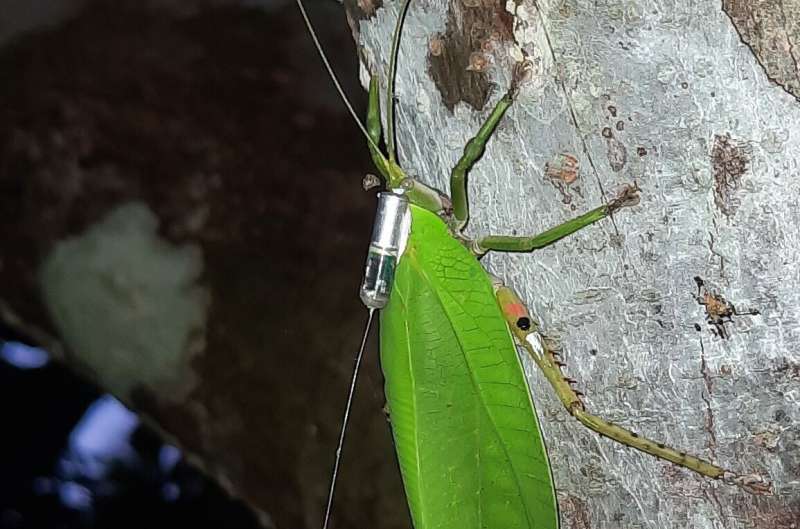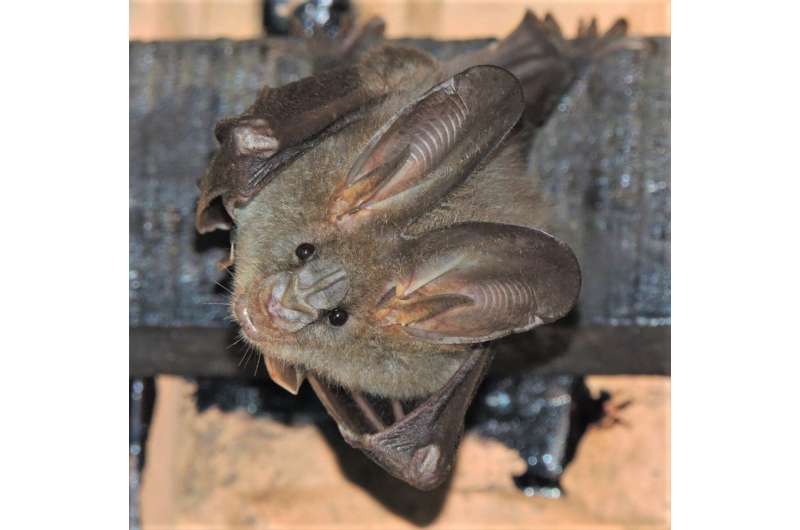This article has been reviewed according to Science X's editorial process and policies. Editors have highlighted the following attributes while ensuring the content's credibility:
fact-checked
peer-reviewed publication
trusted source
proofread
Radio tracking reveals greater predation risk for female katydids

Just like humans, animals move about to find food, shelter, and mates. Movement in the wild, however, comes with increased risk, as it can be tracked by predators.
To understand how katydids (bushcrickets) are hunted by their predator—the lesser false vampire bat—a group of researchers led by Rohini Balakrishnan, Professor at the Center for Ecological Sciences (CES), Indian Institute of Science (IISc), fitted tiny radio tags onto these insects and tracked their movement in the canopy. They found that female katydids are at greater risk than males, likely because the former are frequent fliers who cover longer distances.
Published in Behavioral Ecology and Sociobiology, this is the first insect radio tracking study in India, explains Harish Prakash, postdoc at CES and an author of the paper. He says that in addition to field observation, they carried out experiments in a controlled environment to answer key research questions on predator-prey interactions.
Lesser false vampire bats—native to South and Southeast Asia—bring their prey back to their roost to eat. A large proportion of the bat diet consists of insects like katydids. In earlier studies, Balakrishnan and others found that there were a lot more remnants of female wings than males, suggesting that the bats preferred to prey on female katydids. This was unexpected, because katydid females are usually silent, unlike the males that make themselves conspicuous by calling out to attract the females. This led the researchers to ask the question: What about katydid females made them more attractive to the bats?

One possibility is that bats can detect females more easily, since they are usually larger than males. Second, female katydids might be more nutritious than males and therefore preferred by bats. To test these possibilities, the researchers focused on a group of katydids called "whistlers," in which females are almost double the size and weight of the males. They presented free-flying whistler females as well as males to bats in a large, outdoor cage. Surprisingly, the bats approached both males and females with equal frequency. In fact, in this experimental setup, females escaped capture more often than males. So, it was not the size or nutritive value of the females that increased the risk of their predation.
Then the researchers hit on a third possibility: perhaps the females were flying out more often. To test this, the team glued tiny radio transmitters onto the backs of male and female katydids and tracked them as they flew across trees. What they found was that females tend to move 1.5 times more frequently and 1.8 times farther than males.
This led them to conclude that flying more frequently and traveling longer distances across trees may put females at a higher risk of being hunted by bats than males. Kasturi Saha, Ph.D. student at CES and corresponding author on the paper, suggests a possible reason for these frequent long flights: "The females may move around in search of mates, as well as suitable egg-laying sites."
"In systems where males produce conspicuous acoustic signals and females move silently, it has been assumed that males rather than females perform the higher-risk behaviors," says Balakrishnan. However, contrary to this view of risk-taking males and risk-averse females, the current study shows that female katydids might be at greater risk of predation.
There are still many unanswered questions about the predator-prey interactions. For example, Saha explains that the bats seem to hunt more female katydids during non-breeding seasons. "This is another mystery we are trying to solve."
More information: Kasturi Saha et al, Is flying riskier for female katydids than for males?, Behavioral Ecology and Sociobiology (2023). DOI: 10.1007/s00265-023-03298-7
Journal information: Behavioral Ecology and Sociobiology
Provided by Indian Institute of Science



















